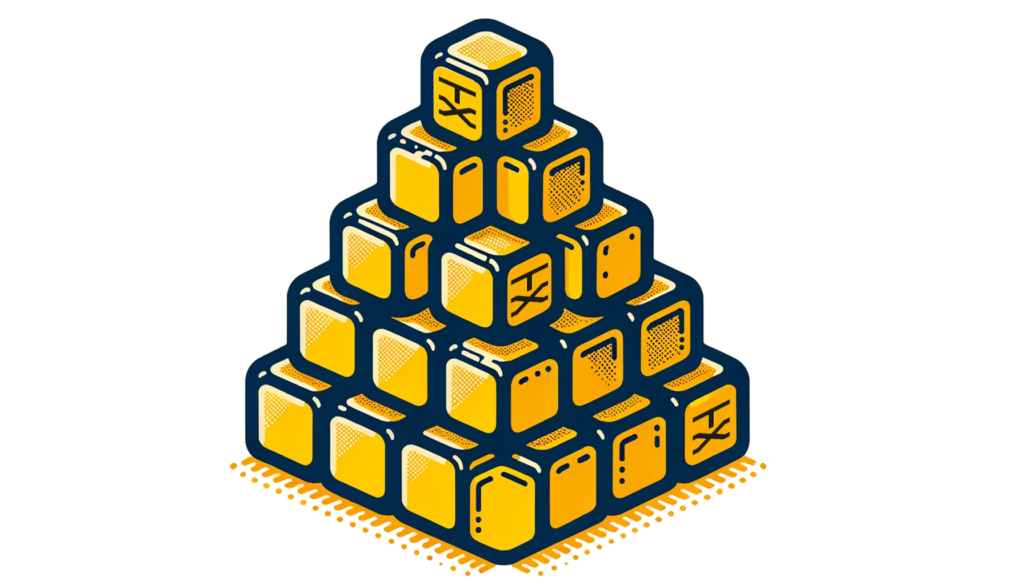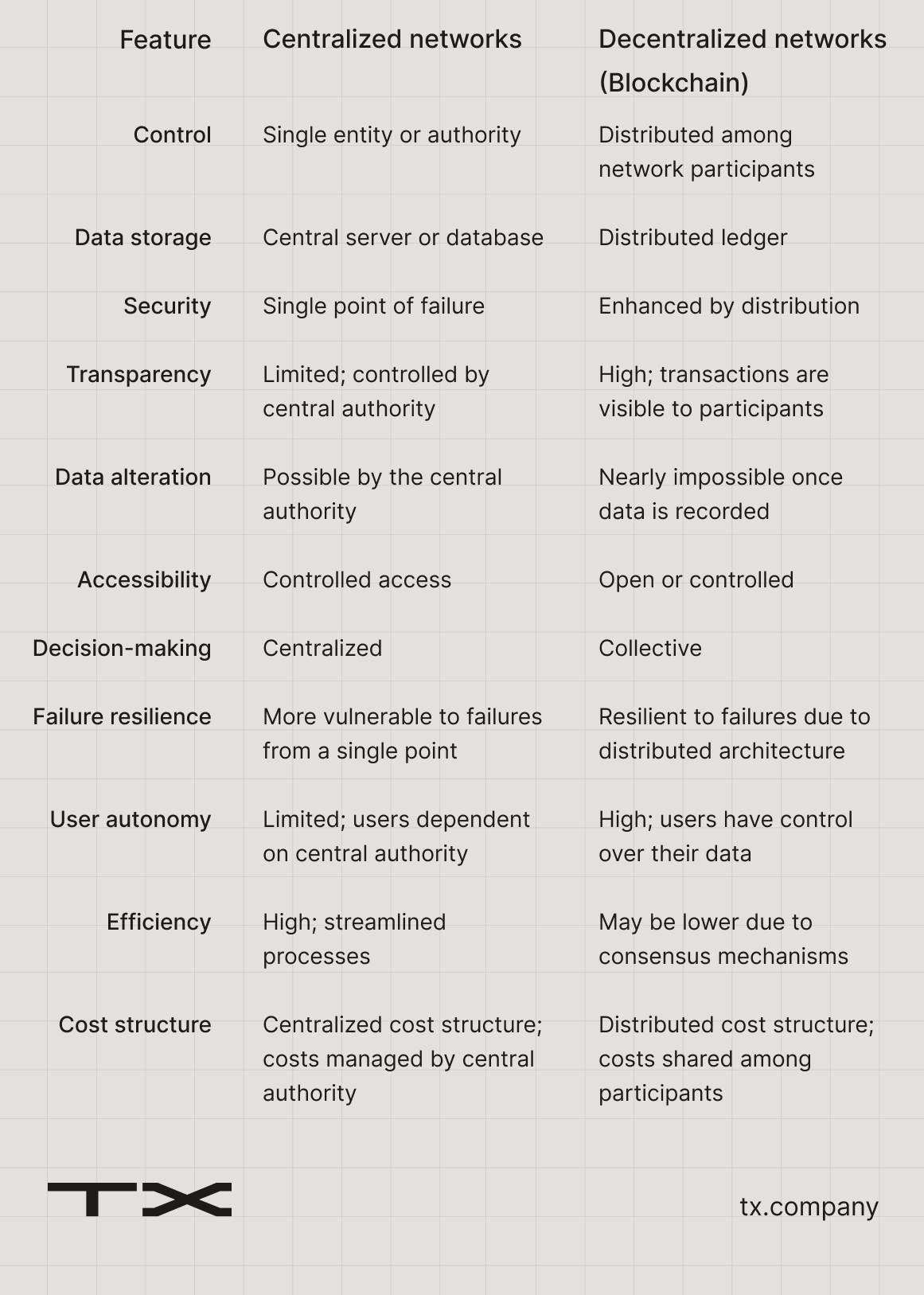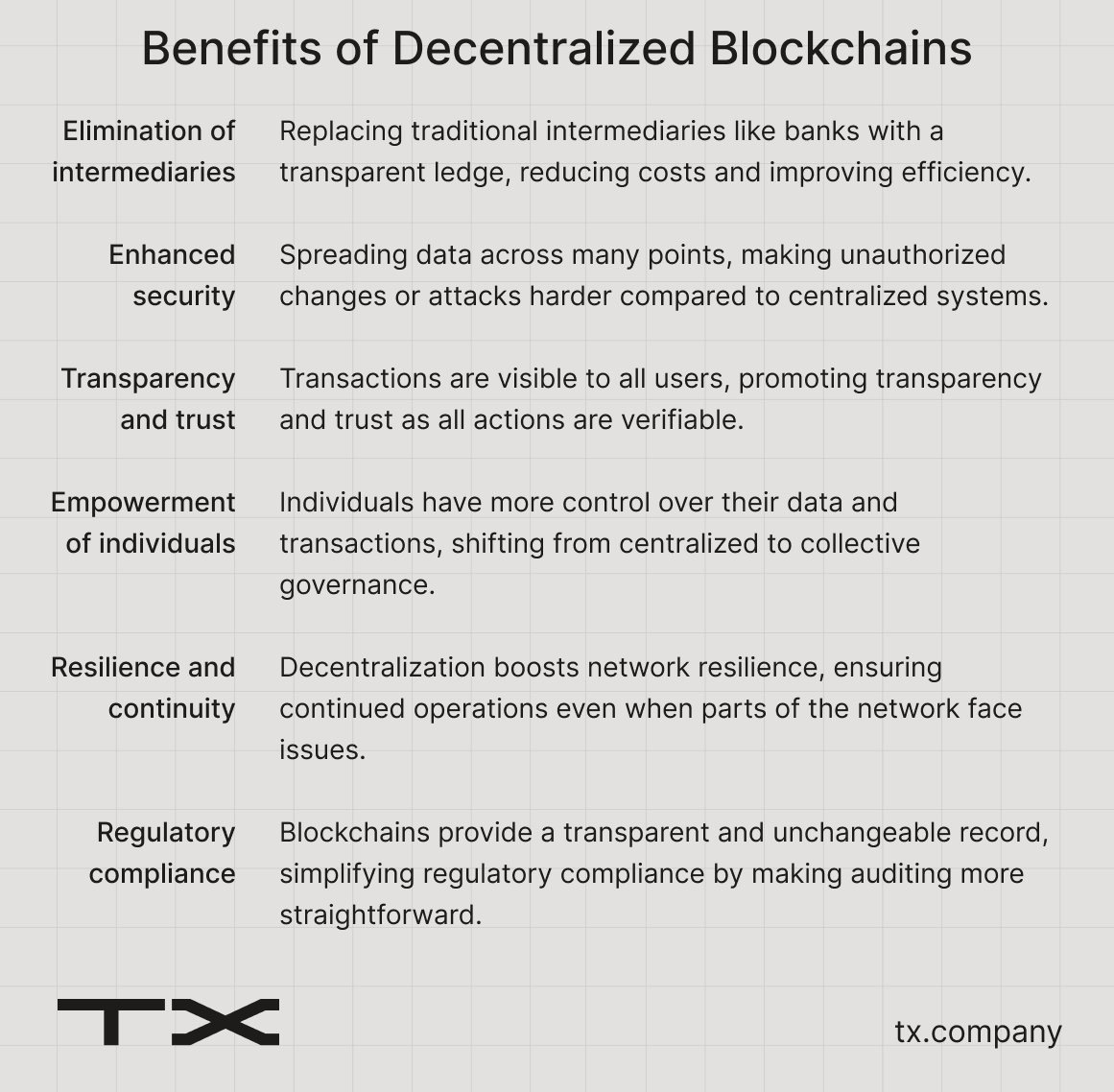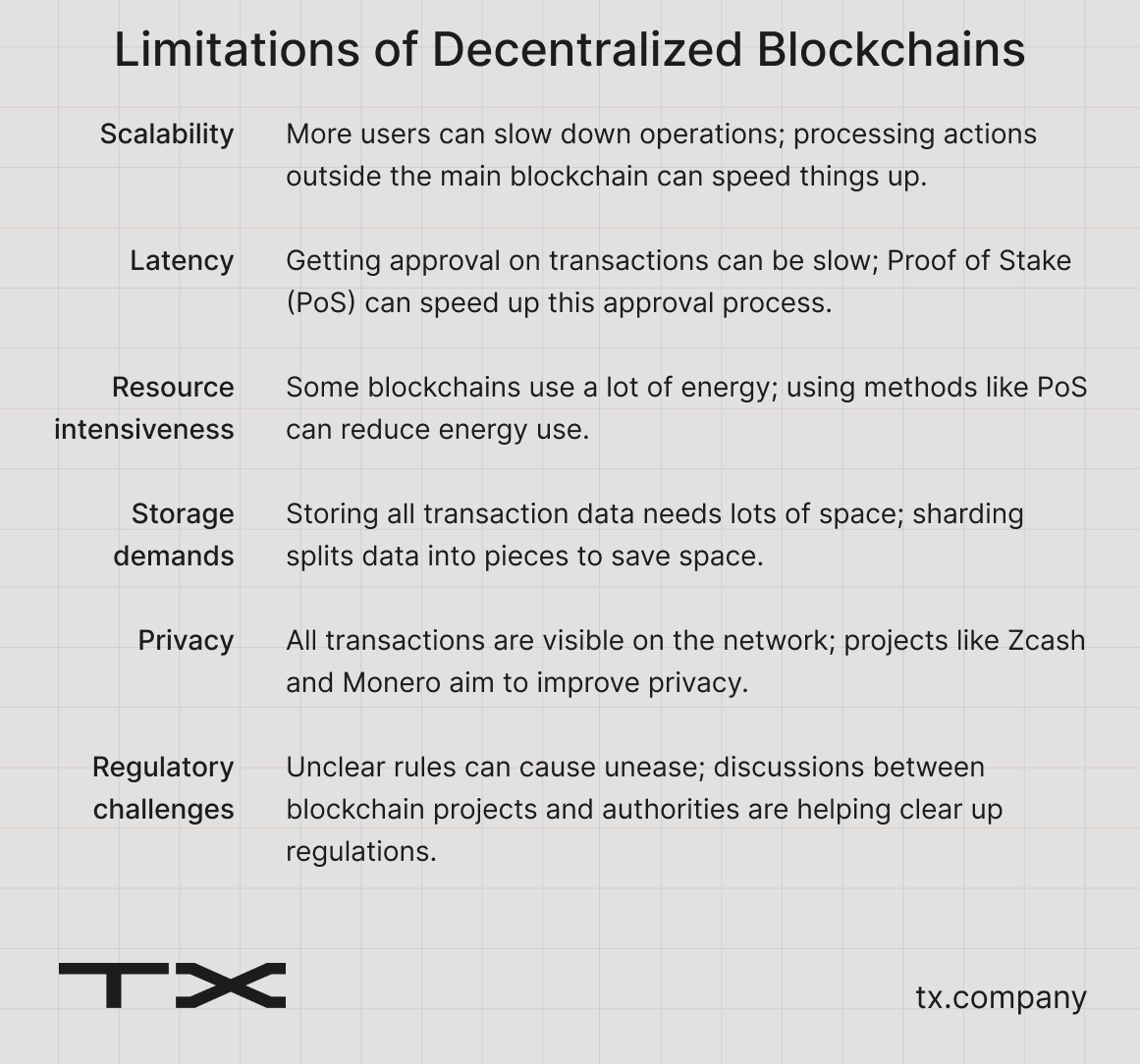2023-10-25

Marketing Lead at TX
In this article, we’ll look at how decentralization is expressed in blockchains. This blog post should be simple enough to follow even if you are still new to Web3-related technologies. If you need help following, look at our blog post explaining 10 key Web3 concepts.
The most important thing to understand, at the very least, is that blockchains and decentralized networks are closely related but not identical. A blockchain is a type of decentralized network characterized by a shared, immutable ledger of transactions. Decentralized networks, on the other hand, are a broader category of distributed networks, where control and data are distributed among participants rather than being centralized. In other words, blockchain is a specific technology under the broader umbrella of decentralized networks.
Furthermore, not all blockchains function similarly regarding openness, the degree of decentralization, and so on. Therefore, the different features discussed later in this text are more like general guidelines than universal truths.

In this article
What is decentralization in blockchain?
Blockchains are similar to logbooks, where each action is recorded on its pages. When the pages are filled, a new logbook is started – volume 2, volume 3, and so on. In this case, each logbook is represented as a block, and when each new volume is connected, it begins to create a blockchain.
In addition, once an action is recorded, it can’t be altered retroactively. This permanence or immutability is a key feature across blockchains. Therefore, the information is more comparable to being set in stone than written in paper logbooks.
In a decentralized blockchain network, participants who maintain and update the “logbooks” are also known as network nodes, and each node holds a copy of all the actions that have been recorded on their pages. This collective record-keeping makes the network transparent, as every transaction is visible to all.

Moreover, before any action gets approved and added, it must be validated by several nodes. This verification process adds security to the data contained in the system because a compromised central authority cannot corrupt the stored information. Instead, multiple nodes need to be compromised to cause a catastrophic failure in the whole blockchain process.
Why is blockchain technology needed?
In the digital realm, the concept of control often circles around a central authority. This authority could be a big tech company, a government, or any other centralized entity that holds the reins over data and decisions. Blockchain introduces a shift from this norm through decentralization, where no singular entity is calling the shots. Instead, control is distributed among many participants within a network, paving the way for a more open system.
The decentralized nature of blockchain fosters a sense of community and collective governance. It’s often not about one powerful actor dictating terms but a collaborative effort where decisions are made together. This way, blockchain decentralization empowers individuals and creates a level playing field in digital interactions.
Additionally, decentralization in blockchain opens up avenues for innovations. It lays the foundation for a new wave of applications and platforms where users are in control, not just a spectator to the whims of a central authority. Through decentralization, blockchain is not just rewriting the rules but is setting the stage for a more inclusive digital ecosystem.
Centralized vs. Decentralized networks
The difference between centralized and decentralized networks hinges on control and access. In a fully centralized network, one party decides who gets access to the network, and all decision-making goes through that party.
On the other hand, in decentralized networks, parties operate more independently. Control and decision-making are spread out, reducing the risk associated with a single point of authority. It’s a setup that encourages open participation and fosters resilience.
However, depending on how power is distributed in the network, even a decentralized setup may include parties with significantly more influence over others rather than being completely democratic and equal.
Decentralized networks, as embodied by blockchain, dismantle the traditional hierarchies of control and create a more inclusive environment. They eliminate single points of failure, enhance security, and promote transparency, making them a more appealing choice for those looking to escape the limitations of centralized systems.
The following table is a brief overview of some of the main differences between the two types of networks:

Types of decentralization in blockchain
Decentralization unfolds in various forms, each with its unique impact on network operations and user interactions. These diverse types of decentralization contribute to blockchains’ robustness, transparency, and inclusivity. They tackle different dimensions, including who has control, where the network operates, and how transactions are processed, thereby shaping blockchain networks’ overall architecture and functionality.
As we delve deeper into these types, we unravel the layers of decentralization that collectively empower individuals, enhance security, and foster a collaborative digital ecosystem within blockchain networks.
Transactional Decentralization
Transactional decentralization is about changing the way we do business transactions. Instead of having one main boss or company in charge of overseeing and managing transactions, a new decentralized approach lets the parties involved talk and deal directly with each other. This is made possible with something called smart contracts, which are just digital agreements that automatically make sure everyone sticks to their part of the deal when certain criteria are met. For instance, sending over a payment after the delivery of goods.
The big advantage here is making business dealings quicker and cheaper because we cut out the intermediary, like a boss or a company that oversees and validates transactions.
Bitcoin is probably the most known example of direct (or peer-to-peer) transactions between users, although many services have been established to make the process more user-friendly.
Physical Decentralization
Physical decentralization is like having different filing cabinets for a company’s documents spread out in offices around the world instead of just having all the cabinets in one office. This way, no single office or place controls all the company’s information.
For a more tech-oriented answer, the blockchain network’s servers are spread across different geographic locations instead of a single server farm or data center housing all the servers.
Architectural Decentralization
Architectural decentralization refers to the number of computers or systems involved in a blockchain network. The more computers involved, the stronger and more reliable the network is. This setup helps ensure the network continues functioning even if some computers or systems encounter problems.
Political Decentralization
Political decentralization is concerned with the governance of the distributed network itself. Instead of a single person or organization controlling the entire network, control is distributed among multiple individuals or groups. This distribution of control helps in reducing the risks associated with having a single authority.
Logical Decentralization
Logical decentralization is about how a network behaves. For instance, a blockchain could be spread across many computers (architecturally decentralized) and not controlled by a single central entity (politically decentralized), yet operate as a single logical entity or “network.”
Logical decentralization looks at the big picture and whether the network operates as a single cohesive team or has multiple, distinct groups functioning under similar principles.
For example, franchises like McDonald’s have many independently owned outlets (architectural) with no single person controlling all of them (political). Yet, they all follow the same branding, menu, and operational guidelines, thus operating as one single entity.
Another example is a public transport network where various bus or tram lines operate independently with distributed control. Yet, when they share a common ticketing and scheduling system, they become logically centralized, providing a unified service to riders.
Benefits of a decentralized blockchain implementation
The essence of blockchain’s decentralization lies in its quest for openness, security, and a collective consensus. It’s a reaction to the traditional centralized systems where a singular authority holds sway over data, decisions, and access. The benefits include:
Elimination of intermediaries
In traditional transactions, intermediaries like banks or regulatory bodies are essential for trust. However, blockchain’s decentralized nature replaces these intermediary roles with a transparent, immutable ledger, reducing costs and increasing efficiency.
Enhanced security
Centralized systems present a single point of failure, making them enticing targets for malicious attacks. On the other hand, decentralized blockchains distribute data across numerous nodes, making unauthorized alterations or hacks exponentially more challenging.
Transparency and trust
In a decentralized blockchain, every transaction is visible to all network participants, fostering transparency. This openness cultivates trust among network users, as actions within the network are verifiable by all network members.
Empowerment of individuals
Unlike centralized structures where power is concentrated, blockchain decentralization empowers individuals with control over their data and transactions. It’s a shift from siloed control to collective governance.
Resilience and continuity
Decentralization enhances network resilience. Even if parts of the network encounter issues, the distributed architecture ensures continuity of operations.
Regulatory compliance
By providing transparent and immutable records, decentralized blockchains can aid in regulatory compliance, making auditing more straightforward.

Limitations of a decentralized blockchain network
It wouldn’t be fair to rave on about the positive sides only and ignore some of the obvious limitations that current blockchain technologies face. So, let’s have a look at some of the current limitations and brief examples of how those issues are being tackled.
Scalability
The more people use a blockchain, the slower it can get, making it challenging to handle many transactions quickly. One way to tackle this is to handle a bunch of transactions outside the main blockchain (on another network “layer”) and then finalize the transactions directly on the blockchain.
Latency
Blockchains require a consensus to validate transactions, which can be slow. New consensus mechanisms like Proof of Stake (PoS) are more efficient as they require less computational work to validate transactions, speeding up the process.
Resource Intensiveness
Some blockchains require a lot of computational power, which can be energy-intensive. Transitioning to energy-efficient consensus mechanisms like Proof of Stake and developing eco-friendly blockchain platforms are steps to reduce blockchain operations’ environmental impact.
Storage Demands
Storing all transactions on every node demands a lot of storage. Techniques like sharding are being used to reduce this burden. Sharding breaks the data into smaller pieces, distributing it across the network, which reduces the amount of data each node needs to store.
Privacy
All transactions are visible to everyone on the network, which can be a privacy concern. Privacy-focused blockchain projects like Zcash and Monero are working to enhance privacy features, offering more secure and private transaction options.
Regulatory Challenges
Uncertain regulations can create an uneasy environment for users and developers. Continuous dialogue and collaboration between blockchain projects and regulatory bodies are helping to shape more explicit regulatory frameworks, providing more certainty.
The European Union’s Markets in Crypto-assets Regulation (MiCA) for 2024 is an awaited policy package for the industry and it will undoubtedly set a reference point for future policies outside the EU as well.

Despite these limitations, the relentless innovation within the blockchain space continues to address these challenges, aiming to harness the full potential of decentralization while mitigating its downsides. The journey of decentralization is pursuing a more open, equitable, and user-empowered digital landscape, albeit with hurdles along the path.
Summary
We have now explored the core aspect of blockchains: decentralization, and how it changes the way we handle transactions, manage data, and make decisions collectively. I’ve tried to simplify the concepts of how decentralized blockchain networks contrast with centralized systems, their various forms, and their potential benefits and limitations.
This blog was just one stepping stone toward understanding the broader decentralized digital realm. If you are taking your first steps in Web3, explore next what a decentralized application (dApp) is or how a Decentralized Autonomous Organization (DAO) leverages blockchain technology.
Drop us a message to discuss your project
We’ll get back to you as soon as possible.
Find out more
For information on how we can transform your sector or business, please get in touch using the contact details below.





